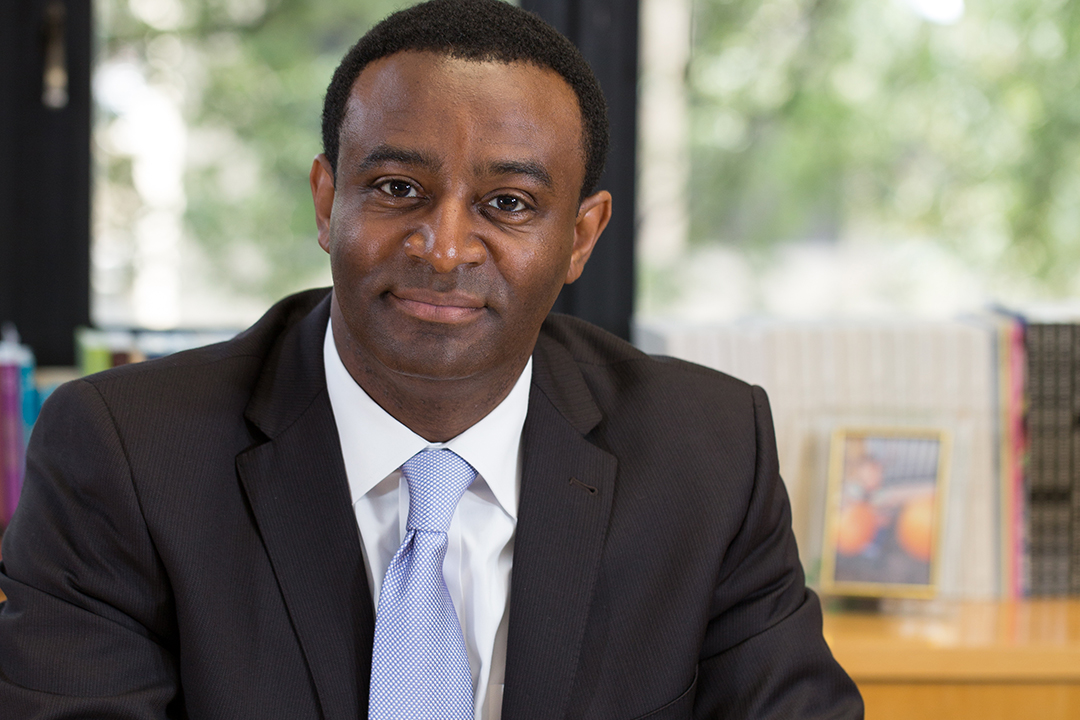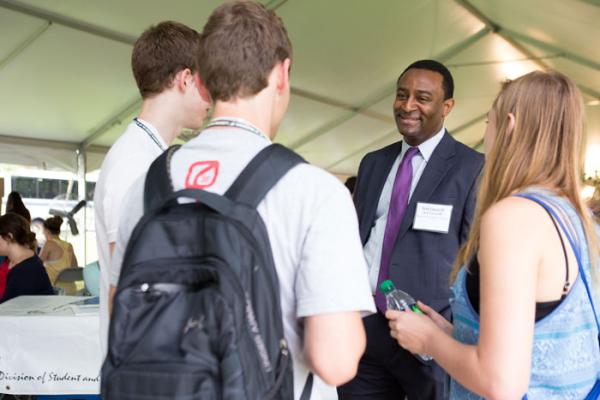Ben Vinson, dean of the Columbian College of Arts and Sciences, recently reflected on his vision for an “engaged liberal arts” and the overall educational enterprise. As the college marks the two-year anniversary of his deanship and the beginning of another academic year, the following are some of his thoughts on the path ahead.
Q: You’ve often talked about the “engaged liberal arts” as the singular component of your academic vision. Tell us more about this concept and what it means for Columbian College?
Since becoming dean two years ago, I’ve had countless conversations with faculty, students, staff, administrators, alumni and community members about how we can best prepare our students to confront the multiple challenges of our 21st century world. Based on those conversations, I’ve become convinced that what make us unique—what distinguishes us as an exceptional place of higher learning, and is a hallmark feature of how we prepare our students—is that we have become home to what I call the “engaged liberal arts.” We are a place that excels in numerous classic arenas of collegiate education such as political science, math, history and the languages, but at the same time we offer so much more. Through graduate programs such as art therapy and museum studies, through professional schools embedded in the college, through the ways in which we are connected to the nation’s capital through internships and professional ties, and through the ways we are connected to the greater world with our research and teaching, the liberal arts at GW fosters an environment where experimentation is anchored in practical application.
Q: How does an “engaged liberal arts” impact your actions going forward?
The great opportunity before us is bringing many of our programs together synergistically to create the interdisciplinary links and ties that connect some of our graduate and undergraduate programs, and which allow all of the disciplines within Columbian College to work together harmoniously. We have the opportunity to take the classic liberal arts within our college and connect them with the practice-oriented programs that proliferate throughout the university. Based on my conversations, I think that our student body craves multi-faceted ways to analyze problems and think creatively. I want to help deliver this through our curriculum, connections with the community and our student/faculty research experiences. I want to continue exploring ways we can take the engaged liberal arts concept across the university to deliver a well-rounded educational experience that leads to pathways linked to successful opportunities beyond graduation. I also want to explore how we can communicate the engaged liberal arts as a value, as something that every student can understand and see as part of our mission, and that every student understands is the way we conduct our collegiate lives and careers.
Q: Drilling down to the educational enterprise as it relates to the student experience, what do you hope to accomplish this academic year?
I hope to build upon the informal recommendations of a small task force of students and faculty that I convened last year to help me think about the steps ahead. Their recommendations include a sharper focus on capstone experiences, designing a junior year interdisciplinary seminar—similar to our Dean’s Seminars for freshman and our recently launched Sophomore Colloquia—and reinvigorating interest in the senior thesis. These are all items worthy of our attention.
I’ve also been developing with my team of associate deans some other specific goals for the year ahead. For example, we seek to promote more research opportunities for undergraduate students and encourage greater interactions between our students and our alumni in the educational and professionalization experiences, and explore ways to connect our graduate student community more tightly with our undergraduates. We also hope to pursue opportunities for global and diverse experiences, and foster greater student success in the classroom—ensuring strength of courses and continuing to connect internships with curricular experiences.
In addition, we want to work more closely with the Career Services Office to build upon their successes and better link them to the educational curriculum of our programs and departments. I firmly believe that the pathway to career success means better aligning what students learn in the classroom with the outcomes needed to become meaningful contributors in the workforce, armed with knowledge and ways of thinking about the world and its problems in ways that will compel positive change
Q: You’ve been very involved with the Corcoran’s transition into Columbian College and, more broadly, the university. Reflect for a moment on where we’ve been and where we’re going.
As we mark the one year anniversary of what has been a transformative year for the arts at GW, I’m excited about what lies ahead. With the hiring of the Corcoran School’s inaugural director, the veteran arts education leader Sanjit Sethi, I look forward to creating something dynamic and unique in the landscape of arts education.
In the short term, we will make every effort to continue to integrate Corcoran students into the GW community. I was pleased to see Corcoran undergraduates participating in the Colonial Inauguration orientation program this summer and receive housing assignments in residence halls alongside students from across the university’s schools and colleges. Additionally, incoming Corcoran undergraduates will begin taking general education courses this year, and we will continue to encourage all of our students to take advantage of the wide range of university services and resources available to them.
In the long term, we look to integrate all our arts programs under the Corcoran School umbrella. Already, our interior architecture and design program is fully integrated and we are looking to do the same with our museum studies, theatre and dance, and music disciplines.
Q: The other significant moment of your deanship was the opening of Science and Engineering Hall (SEH). How is the facility impacting research and interdisciplinary collaboration?
The full impact of SEH is still being realized but the possibilities for discovery, for breaking ground on new and exciting research, are immense. Putting so much talent from so many disciplines under one state-of-the art roof portends to amazing collaborations and recruitment of the some of the best scientists in the field. Look no further than our research growth during fiscal year 2015 to understand the full breadth of what’s to come. During that time frame, Columbian College submitted more than 270 research proposals and our research expenditures totaled nearly $18 million. Those figures represent a significant increase over the previous year and are a solid measure of our stepped up research activity.
And, for our students, SEH provides extraordinary learning opportunities: the spacious, modern teaching laboratories provide unique educational experiences, and the larger work spaces make it easier to interact with both faculty and students in other disciplines. It’s truly a remarkable facility and I will make every effort to ensure we sustain its capacity for cutting-edge research in the years to come.
“Our student body craves multi-faceted ways to analyze problems and think creatively. I want to help deliver this through our curriculum, connections with the community and our student/faculty research experiences.”
—Dean Ben Vinson



